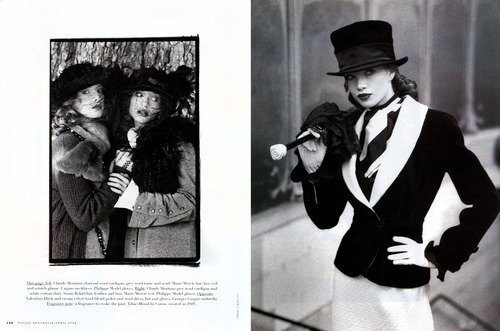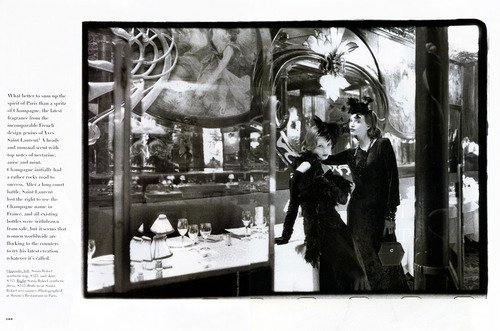Archive
- Behind the Screens 9
- Bright Young Things 16
- Colour Palette 64
- Dress Ups 60
- Fashionisms 25
- Fashionistamatics 107
- Foreign Exchange 13
- From the Pages of… 81
- G.U.I.L.T. 10
- Little Trifles 126
- Lost and Found 89
- Odd Socks 130
- Out of the Album 39
- Red Carpet 3
- Silver Screen Style 33
- Sit Like a Lady! 29
- Spin, Flip, Click 34
- Vintage Rescue 20
- Vintage Style 157
- Wardrobe 101 148
- What I Actually Wore 163
Hurrah and Farewell!

It’s the end of a decade, and I’m sending off these Teensies with some 1910s fashion: some antique cotton bloomers and a modern printed cotton dress worn tunic style, which is very reminiscent of Edwardian-era bathing costumes.
I used to wear these bloomers as fun shorts in summer as their very voluminous bottoms were so cool in the heat, but those same baggy bums eventually made me retire them to storage. They are a fun thing to have in a vintage collection, but they do not really work with the typically slim 1930s silhouette!
I hope you all have a fun final day of the year, and a wonderful evening celebrating … see you in the Twenties!
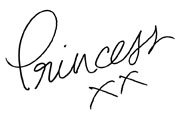
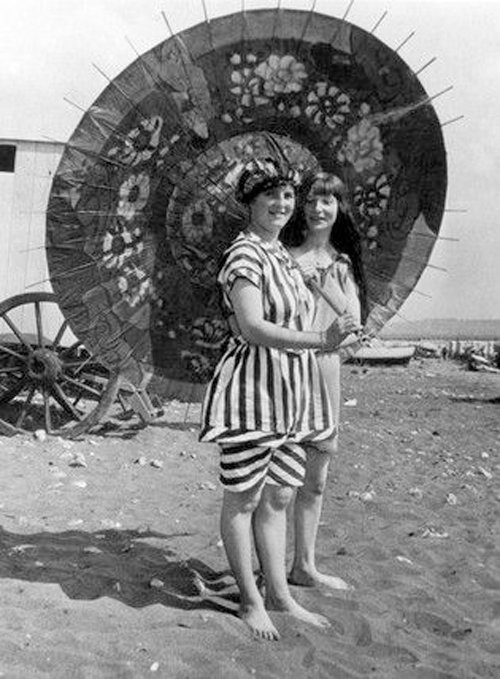
1910 bathing suits – give me that umbrella! Image found on Pinterest
Photo: March 2014
My First Vintage Hats
 My hat collection today is rather vast and spans the entire twentieth century, but once upon a time it was a pitiful assemblage of various caps, berets and sunhats I wore as a teenager and new hats bought in the 1990s. I don’t recall exactly when I bought my first true vintage hats – possibly a 1960s cloche in an op shop (thrift store) – but amongst my oldest hats, and earliest purchases is this pair: an Edwardian era navy felt Tyrolean hat draped in an ostrich-feather, and a 1920s black wool felt half-cloche trimmed in wide grosgrain ribbon.
My hat collection today is rather vast and spans the entire twentieth century, but once upon a time it was a pitiful assemblage of various caps, berets and sunhats I wore as a teenager and new hats bought in the 1990s. I don’t recall exactly when I bought my first true vintage hats – possibly a 1960s cloche in an op shop (thrift store) – but amongst my oldest hats, and earliest purchases is this pair: an Edwardian era navy felt Tyrolean hat draped in an ostrich-feather, and a 1920s black wool felt half-cloche trimmed in wide grosgrain ribbon.
I even remember purchasing these, under rather extraordinary circumstances. I was visiting my sister in Castlemaine, a country Victorian town, and she took me to a kind of magical old colonial house hidden in the centre of town that was seemingly inhabited by a single elderly lady, and her large collection of antiques and vintage fashion. We spoke in hushed tones as we entered the dimly-lit interior in the Victorian style, dark and every space covered in some sort of decoration.
My sister had already warned me about the vintage perambulator, in which the lady kept a baby doll (strangely similar to the late Australian artist Mirka Mora who once told me she often bumped it into doorways, after she saw me do the same with my shopping trolley!). The eccentric owner appeared, and upon learning that I was interested in looking at hats, allowed me to examine some up close.
 When she saw just how interested I was, she told me she had many more hats upstairs, in the empty rooms, and she lead me up. What followed remains a hazy memory in my mind’s eye, like a surreal dream as I darted through room after room, gasping at such a treasure trove of hats. They were piled everywhere, on the furniture and gathering dust.
When she saw just how interested I was, she told me she had many more hats upstairs, in the empty rooms, and she lead me up. What followed remains a hazy memory in my mind’s eye, like a surreal dream as I darted through room after room, gasping at such a treasure trove of hats. They were piled everywhere, on the furniture and gathering dust.
Eventually I settled on three – the Tyrolean cap the owner kept putting away, as though she was reluctant after all to part with it, until I firmly insisted on purchasing it, even at the high price of $90 she asked (in the early 1990s, it was a lot for me).
 The third hat was a high-crowned straw, probably 1950s or 60s, painted gold and adorned with black ribbon and three fat roses (you can see that here). You could see the original blue and red straw under the gold spray paint; it might have been a refurbished relic from a theatre’s wardrobe department. Eventually I got rid of that hat, except for the roses which I removed and probably still have stored somewhere. I also bought a 1960s short jacket in a Regency style: it was sky-blue linen with silver lurex braid; that also has long-since departed my closet.
The third hat was a high-crowned straw, probably 1950s or 60s, painted gold and adorned with black ribbon and three fat roses (you can see that here). You could see the original blue and red straw under the gold spray paint; it might have been a refurbished relic from a theatre’s wardrobe department. Eventually I got rid of that hat, except for the roses which I removed and probably still have stored somewhere. I also bought a 1960s short jacket in a Regency style: it was sky-blue linen with silver lurex braid; that also has long-since departed my closet.
I’m pleased though that these two have lasted the test of time, as I still wear them today.
Photos: September 2019
Feathered Fantasies
 Models at the Hippodrome de Longchamp, showing off scandalous new gowns showcasing the S-line (and their figures), and enormous hats of course, Paris 1908During the Edwardian period, the ideal image of womanhood was to look fragile and delicate, and the fashion was for the flattering S-line, with long luxurious hair piled high to show off slim necks. Enormous hats fantastically trimmed were the crown of these ensembles, designed to complement and set off the feminine silhouette.
Models at the Hippodrome de Longchamp, showing off scandalous new gowns showcasing the S-line (and their figures), and enormous hats of course, Paris 1908During the Edwardian period, the ideal image of womanhood was to look fragile and delicate, and the fashion was for the flattering S-line, with long luxurious hair piled high to show off slim necks. Enormous hats fantastically trimmed were the crown of these ensembles, designed to complement and set off the feminine silhouette.
The years of the Edwardian British period covers the short reign of King Edward VII, 1901 to 1910, although sometimes it includes the years up to WWI. At this time, hats were a crucial part of the dress code for people from all walks of life, young or old, rich or poor. There were different hats acceptable for each strata of society – but all wore hats, all the time. Women changed their hats with their outfits several times a day and would never step out tête-nue (with a bare head) – that was considered a huge social solecism. It was acceptable only for beggars to be hatless.


 1909
1909
 A lady and an assistant settle down to the pleasures of selecting and decorating a stylishly large hat from the befeathered and beribboned collection available at the Paquin couture house millinery rooms, 1909. From ‘The Golden Age of Style’ by Julian Robinson, Orbis Publishing 1976Milliners could and did go to town, extravagantly decorating these wide picture hats with silks and velvets, ribbons and artificial flowers, and after the death of Queen Victoria, bright colours becamse hugely fashionable. The most popular millinery trim of all were feathers, for throughout history, plumes on hats have been a sign of status and wealth. The rich of this time were no exception – some of the hats were insanely huge, even obscenely ostentatious.
A lady and an assistant settle down to the pleasures of selecting and decorating a stylishly large hat from the befeathered and beribboned collection available at the Paquin couture house millinery rooms, 1909. From ‘The Golden Age of Style’ by Julian Robinson, Orbis Publishing 1976Milliners could and did go to town, extravagantly decorating these wide picture hats with silks and velvets, ribbons and artificial flowers, and after the death of Queen Victoria, bright colours becamse hugely fashionable. The most popular millinery trim of all were feathers, for throughout history, plumes on hats have been a sign of status and wealth. The rich of this time were no exception – some of the hats were insanely huge, even obscenely ostentatious.
Feathers of all kinds were fashioned by the 800 plumassiers in Paris that employed around 7000 people. Anything from little spiky trimmings to boas, tufts and sprays of feathers called aigrettes were cut, dyed and arranged from a wide variety of feathers: cockerel, pheasant, marabou, ostrich, ospreys, herons or birds of paradise. Sometimes even whole stuffed birds perched atop these monstrosities.
 Bird of paradiseSuch decorations were extremely expensive; a hat trimmed with natural bird of paradise plumes could fetch a price of $100, a fortune in those days – that is over AU$4,400 or US$3,045 in today’s values. (For comparison I spotted a YSL black rabbit fur felt hat on Farfetch for over $3000 – it does have an elegant shape and details, for example tasselled ties, but that seems laughably overpriced for a comparatively unexciting hat made of inexpensive materials.)
Bird of paradiseSuch decorations were extremely expensive; a hat trimmed with natural bird of paradise plumes could fetch a price of $100, a fortune in those days – that is over AU$4,400 or US$3,045 in today’s values. (For comparison I spotted a YSL black rabbit fur felt hat on Farfetch for over $3000 – it does have an elegant shape and details, for example tasselled ties, but that seems laughably overpriced for a comparatively unexciting hat made of inexpensive materials.)
 The feathers of the Roseate spoonbill are so gorgeous they almost lead them to extinctionAnother bird that was hunted almost to extinction is the roseate spoonbill – in the late nineteenth century its feathers were literally worth more than gold – $32 per ounce, compared with $20 for gold. [al.com] Their almost total disappearance was one of the factors that lead to the formation of the Audobon Society, dedicated to conservation, eventually leading to the banning of the usage of feathers from endangered species.
The feathers of the Roseate spoonbill are so gorgeous they almost lead them to extinctionAnother bird that was hunted almost to extinction is the roseate spoonbill – in the late nineteenth century its feathers were literally worth more than gold – $32 per ounce, compared with $20 for gold. [al.com] Their almost total disappearance was one of the factors that lead to the formation of the Audobon Society, dedicated to conservation, eventually leading to the banning of the usage of feathers from endangered species.
 Fashions at Longchamp
Fashions at Longchamp Fashion from Paris – Les Modes February 1907
Fashion from Paris – Les Modes February 1907 c. 1912
c. 1912 Jane Renouardt
Jane Renouardt c. 1900 The Bonita Hat – Huge oblong circle shape made of black plush with flamboyant turquoise lining that shows. It is trimmed with black and turquoise ostrich plumes. There is a turquoise and purple ribbon and velour 'grapes' on the ribbon. Originally sold on Ruby Lane.Three out of four hats featured feathers or whole birds, such was the popularity of plumage in the Victorian and Edwardian eras. Today, feathers are still popular of course, but milliners have become more creative with the feathers from farmed ostriches, pheasants, ducks and cockerels.
c. 1900 The Bonita Hat – Huge oblong circle shape made of black plush with flamboyant turquoise lining that shows. It is trimmed with black and turquoise ostrich plumes. There is a turquoise and purple ribbon and velour 'grapes' on the ribbon. Originally sold on Ruby Lane.Three out of four hats featured feathers or whole birds, such was the popularity of plumage in the Victorian and Edwardian eras. Today, feathers are still popular of course, but milliners have become more creative with the feathers from farmed ostriches, pheasants, ducks and cockerels.
During the militant phase of the Suffragettes and Blue Stockings around 1908, fashion began to simplify, and while hats were still de rigeur, they too fell in line with Reform fashions, for not even Suffragettes would cease wearing hats entirely – they were reluctant to outrage the establishment so utterly. Huge bows in sumptuous fabrics became more favoured for trimming, with the first cloches appearing in 1917, heralding the way for a vastly different style of hat in the 1920s.
 Simpler hats of the latter Edwardian years, top right 1910, all others 1912
Simpler hats of the latter Edwardian years, top right 1910, all others 1912 Hat featuring a fabulously huge bow, Ladies Home Journal, 1910
Hat featuring a fabulously huge bow, Ladies Home Journal, 1910
Photos: Vintage images found on Pinterest; I have tried to include information and original links where available.
Additional reference: The Century of Hats, Susie Hopkins, Chartwell Books 1999
Fashion Follows Sailor Suit
 Late last spring, just as the warmer weather was beginning in Melbourne, I amused myself (and my work colleagues) by adopting a nautical theme for a week. I have long loved stripes – a nautical staple – and the classic colour combination of blue, red, and white which I very often choose to wear, nautical theme or not.
Late last spring, just as the warmer weather was beginning in Melbourne, I amused myself (and my work colleagues) by adopting a nautical theme for a week. I have long loved stripes – a nautical staple – and the classic colour combination of blue, red, and white which I very often choose to wear, nautical theme or not.

Traditional sailor suits … influenced the design of the new bathing suits and other clothing …
Nautical fashion has for many decades been popular for the warmer seasons, with its obvious link to seaside activities. The fashion first took off in the mid nineteenth century, when ‘sportswear for the new woman’ first started being produced. Traditional sailor suits, ie, naval uniforms with flap collars, stripes and bellbottoms, influenced the design of the new bathing suits and other clothing designed for regattas, yachting, boating and seaside promenading.
 Coco Chanel in the interwar period
Coco Chanel in the interwar period French sailors; the marinière or tricot rayé (striped sweater) is a cotton long-armed shirt with horizontal blue and white stripes, characteristically worn by quartermasters and seamen in the French navy.Coco Chanel was another enormous influence after adopting the sailor-collared top (as opposed to Breton striped tees) worn by the local fishermen and sailors in the resort town of Deauville, where she opened her first store on the coast of France in 1913. At the same time, ‘Middy’ blouses, inspired by the uniform of midshipmen were worn by school children for gym activities; by the 1920s they were a huge women’s fashion trend.
French sailors; the marinière or tricot rayé (striped sweater) is a cotton long-armed shirt with horizontal blue and white stripes, characteristically worn by quartermasters and seamen in the French navy.Coco Chanel was another enormous influence after adopting the sailor-collared top (as opposed to Breton striped tees) worn by the local fishermen and sailors in the resort town of Deauville, where she opened her first store on the coast of France in 1913. At the same time, ‘Middy’ blouses, inspired by the uniform of midshipmen were worn by school children for gym activities; by the 1920s they were a huge women’s fashion trend.
 1920s middy shirt
1920s middy shirt Fashion in the decades after followed suit, adopting the look not just for sportswear, but for daywear, and to the present day we are still wearing nautical influenced garments (although it still seems chiefly only for daytime). Every nautical motif once can think of has been deployed by fashion designers in both blatant and subtle iterations, from the triumvirate of the three most popular colours of blue, red and white; stripes and flag graphics; middy tops and sailor collars; neckties and pussy bows; every type of nautical hat – boaters, fisherman and sailor caps; high-waisted bellbottoms; to naval trim such as gold buttons and braid, and rope, anchor and sailboat motifs.
Fashion in the decades after followed suit, adopting the look not just for sportswear, but for daywear, and to the present day we are still wearing nautical influenced garments (although it still seems chiefly only for daytime). Every nautical motif once can think of has been deployed by fashion designers in both blatant and subtle iterations, from the triumvirate of the three most popular colours of blue, red and white; stripes and flag graphics; middy tops and sailor collars; neckties and pussy bows; every type of nautical hat – boaters, fisherman and sailor caps; high-waisted bellbottoms; to naval trim such as gold buttons and braid, and rope, anchor and sailboat motifs.
It’s fun, it’s sporty and casual, easy and breezy, and denotes summertime and carefree holidays so very particularly – no wonder nautical fashion has remained popular!
Click through to view my gallery of all my nautical looks of the week, and keep scrolling for nautical looks throughout the decades.

Read more about nautical Fashion
Stories on nautical fashion by Vintage Dancer and Blue Velvet Vintage are worth a read – both include some great images from different eras.
Genealogy Lady has written a short history on the middy blouse.
Frenchly reveals that Coco Chanel did not make Breton stripes a thing!
For seaside fashion of the nineteenth century, visit Mimi Matthews.
Nautical fashions through the decades
 Victorian era, c 1890s
Victorian era, c 1890s Edwardian wool bathing suit
Edwardian wool bathing suit 1920s swimsuit
1920s swimsuit 1930s nautical daywear fashions
1930s nautical daywear fashions 1940s dress (LIFE magazine)
1940s dress (LIFE magazine) 1950s
1950s 1960s
1960s 1970s
1970s March 1982
March 1982 February 1992, Naomi Campbell and Christy Turlington wearing Ralph Lauren on Vogue's cover
February 1992, Naomi Campbell and Christy Turlington wearing Ralph Lauren on Vogue's cover Les Indes galantes collection, Lascar dress, Haute couture, spring/summer 2000, Jean-Paul Gaultier
Les Indes galantes collection, Lascar dress, Haute couture, spring/summer 2000, Jean-Paul Gaultier Zuhair Murad, RTW Spring 2016All images found on Pinterest unless otherwise indicated with direct links.
Zuhair Murad, RTW Spring 2016All images found on Pinterest unless otherwise indicated with direct links.
À La Mode
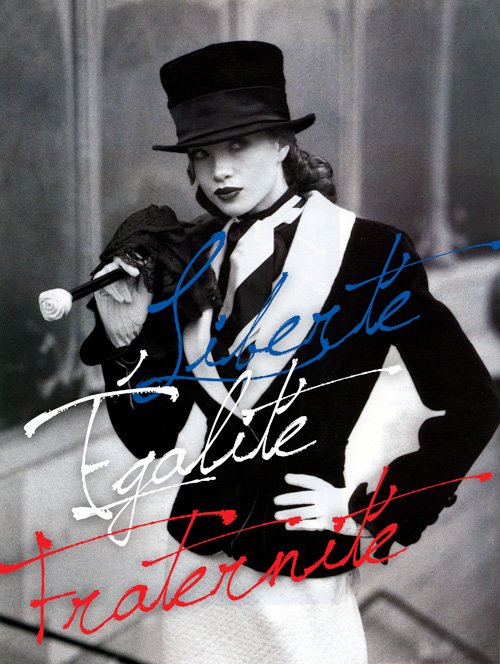 In honour of the French national holiday today, I bring you a Paris-inspired fashion editorial from the April 1994 issue of Australian Vogue, shot by the French photographer Pascal Chevalier.
In honour of the French national holiday today, I bring you a Paris-inspired fashion editorial from the April 1994 issue of Australian Vogue, shot by the French photographer Pascal Chevalier.
The Belle Époque-inspired fashion (some of it French) was photographed around famous sights of Paris, including Maxim’s Restaurant, the famous Art Nouveau entrance to the Metro and the Bois du Boulogne, a park in the 16th arrondissement of Paris.
Bonne fête to my French readership!
[Click on the images for larger versions]






